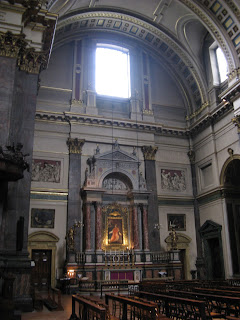This afternoon Mass was celebrated in the Gregorian Rite for the Pope's intentions on the occasion of his 84th birthday in St. Andrew's Church, Bagenalstown (Muine Bheag), Co. Carlow.
Bagenalstown is a town of about 2,500 souls, although it didn't see any noticable increase in population between 2002 and 2006. The town's motto is 'The Irrepressible Number,' which seems to be 65, the number of Bagneltonians who turned out today to celebrate the Pope's birthday with the members of St. Conleth's Catholic Heritage Association.
The body of the Church of St. Andrew c. 1817 is attributed to Thomas Cobden, the architect of Carlow Cathedral. The Church was renovated, with the addition of the steeple, and was rededicated on 9th October, 1893. Dr. Shennan, Bishop of Waterford and Lismore (r.1892-1915), preached the sermon on the occasion in the presence of Dr. Lynch, Bishop of Kildare and Leighlin (r. 1888-1896). The porches were added in 1917, and the Sodality Chapel was added for the Marian Year, 1954.
The Sanctuary extension is the work of William Hague (1836-1899), the Diocese's most prolific architect, who had already completed Churches at Clane (1876-1884), Monasterevin (1880), Rathvilly (1883-1887), White Abbey, Kildare (1884-1889), Rathanna (1885), Rathoe (1885-1889), The Hollow (1887), and commenced at Abbeyleix (1892-1895) before working on the Sanctuary of St. Andrew's, Bagenalstown (1893) for Very Revd. Fr. Edward Burke, P.P., who had been a Professor in Carlow College when Hague had built a new wing (1879) and a College Chapel (1885-88)(now a library!) After Bagenalstown, Hague went on to build the Parish Church at Stradbally (1893-96). He had submitted designs for additions to the Parish Churches of Kildare Town and Newbridge. Certainly Kildare had reason to wish they had accepted his design, as the proposal that was accepted included a statue that fell upon and killed the Parish Priest, Dr. Kavanagh, who had rejected Hague's design as too expensive.





Walter Bagenal (1670-1745) of nearby Dunleckney House laid out the town in an attempt to establish a profitable trade route through his land based upon the River Barrow. It is laid out on a grid pattern lying upon the River Barrow in imitation, it is said, of Versailles. However, the only evidence of the 'New Versailles' planned is the fine old Courthouse overlooking the river that is built in the form of a small classical temple modelled on the Parthenon in Athens. Bagenal had been able to regain the family estates from the Crown by perverting to the Church of Ireland. He was the father of the famous rake Beauchamp Bagenal. References to 'the Lord Bagenal' appear to have arisen from the 'lordly bearing' of Beauchamp. There was never a title in the family.
Walter's father, Colonel Dudley Bagenal (1638-1712) had his Carlow estates, lost previously under the Cromwellian regime, restored by King Charles I. He fought in the Battle of the Boyne as a Colonel of an Infantry Regiment, was declared a traitor by William of Orange and his estates were again forfeit. He was Gentleman Usher to King James II at the Stuart Court in Exile at St. Germains.
Walter's grandfather, and namesake Colonel Walter Bagenal (1614-1652) was executed by Cromwellian troops. He had been Governor of County Carlow in 1641 and Colonel in the Leinster Army of Catholic Confederacy. Walter the elder was the son of George Bagenal (d. 1625), who built Dunleckney House, and Lady Joane Butler, daughter of James Butler, 11th Earl of Ormonde and 4th Earl of Ossory (1569-1632). One of the famous Butlers of Kilcash, James was known as James of the Beads for his great devotion to the Rosary and the Catholic Faith. We spent many years imprisoned in the Fleet Prison in London for opposing James I's disposition of the Butler estates to a cousin who had married one of his Protestant favourites.
George's father, Dudley (d. 1587), who was the grandfather of Walter the elder and the great-great grandfather of Walter the younger (who laid out and built Bagenalstown) was the first of the Bagenal family to come to Carlow and was engaged in a long-running feud with the Kavanaghs of Borris, who were original owners of the lands. Dudley's father, Sir Nicholas Bagenal (c. 1590), was an English adventurer from Newcastle upon Lyme who fled England after killing a man in a brawl in 1539 to became a mercenary for the O'Neills of Ulster. He was pardoned by Henry VIII, who granted him lands in Newry, Co. Down, and created him Marshal-General of the Army in Ireland from 1550 to 1553, a post he held again under both Mary I and Elizabeth.













































































